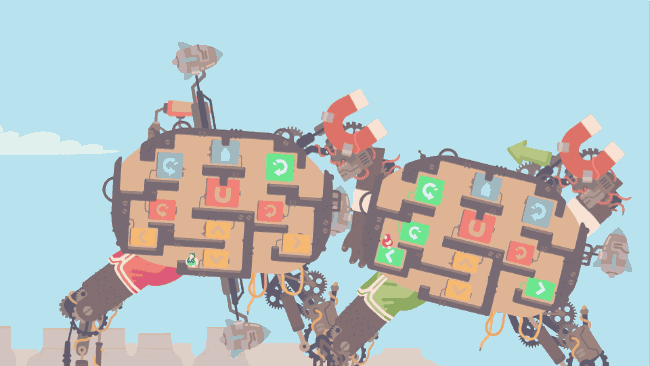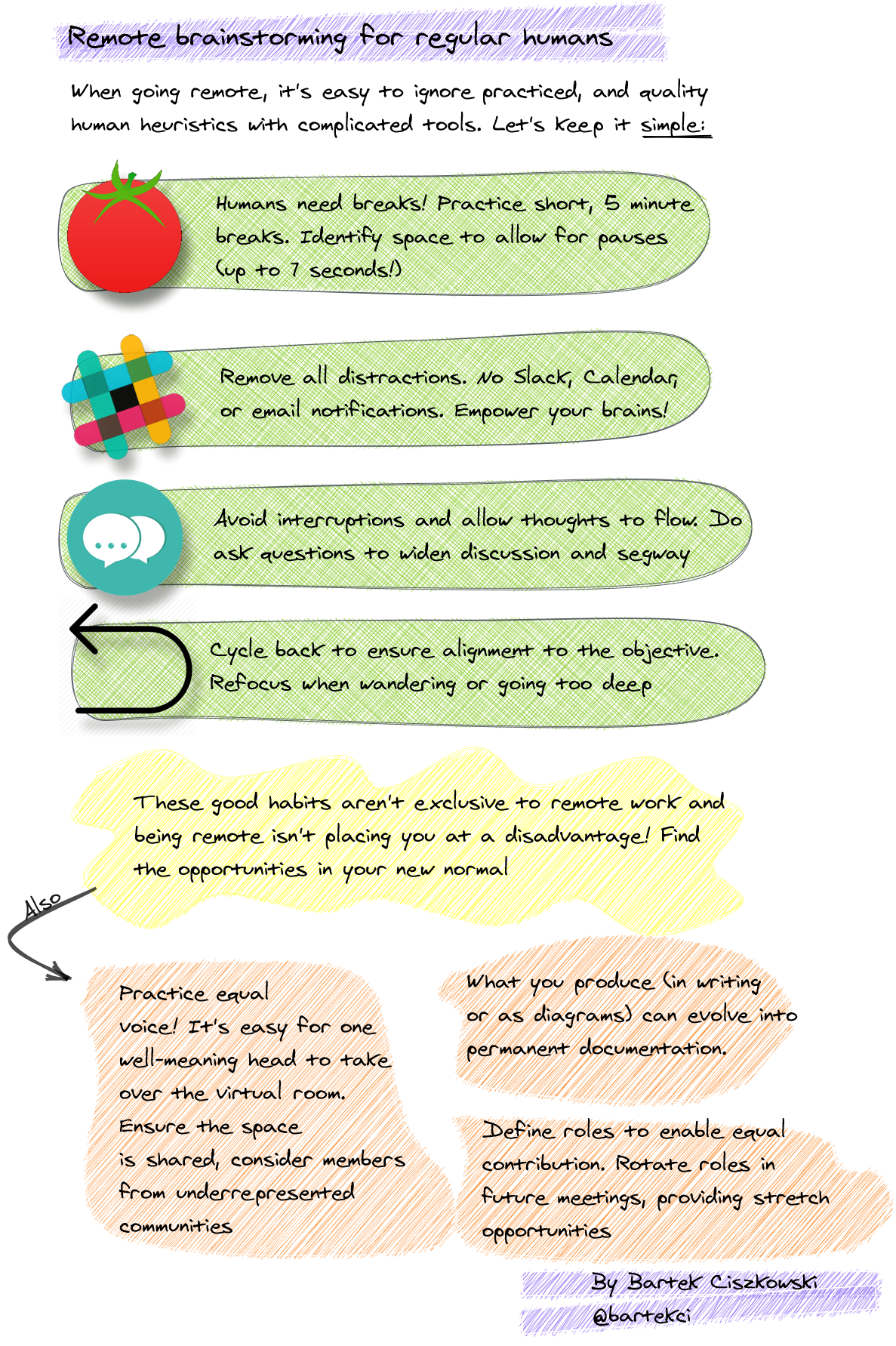Remote brainstorming for regular humans
When going remote, we habitually forget much of what makes us effective in person. Working in the completely different, and at times frustrating, setting of remote sessions may entice us to find expensive, complicated tools to solve our problems. In a brainstorm session specifically, we want to reduce our cognitive load and encourage ideas, thoughts, and questions which lead us to understanding and solving a problem!
When we introduce new tools, rather than focusing on classic, human heuristics, we risk being blinded by shiny-tool syndrome. As I wrote this post, I was reminded of a game I played a few years back, titled Regular Human Basketball. In it, you are a few regular humans trying to control a haphazardly built machine with the goal of scoring against your opponent. The results generally look something like, well, this:

Honestly, that game is fantastic analogy for any dysfunctional process, team, or piece of software. But today we’re going to speak about facilitating a remote brainstorm session, respecting our fellow humans, and actually taking advantage of being fully remote!
By the end of this post, I do think you’ll look back and think, Huh, this all seemed remarkably simple! And it is.
Let’s begin with the virtual room. We’re all in individual rooms, but the facilitation occurs in an exclusively digital space, not physical. We benefit from having everyone remote, and we don’t have the challenge of a smaller subset of — usually ignored — participants joining a filled conference room.
This virtual setting by default enables equal voice but the reality is some may find difficulty in contributing. As a meeting goes on, they may be unsure when to jump in, perhaps they feel as if they are interrupting, asking questions already answered, or not contributing. Just like in-person meetings, you’ll need to be intentional about providing voice for everyone. This can be achieved by asking direct questions, providing space for pauses, or assigning specific, contributory roles to everyone. Most especially consider those new to the team, junior engineers, and those from underrepresented communities. If possible, do your best to get to know them ahead of your time together so you can understand how to best support them. Like you, they are here for a reason and have something to contribute — so provide them the platform!
It’s also wise to consider the number of people. This won’t be your last brainstorm session and you can rotate through various parties, pulling people in and out, iterating until you have reached your goal. So, try to keep it small. I’ve found three to four is effective.
Well ahead of the session, you should be observing the problem. What is the problem? Who does it impact? What measurements do we have in place today to understand how it’s hampering our ability to meet our objectives? If we looked to solve this problem, what would our objective look like? Many of these are reflected as you produce OKRs. If you aren’t there yet, consider what those objectives and key results may look like. This allows you to maintain focus when brainstorming. I won’t speak much on this topic today, and rather highlight a fantastic piece by Teresa Torres from Product Talk, which gets you thinking proper on defining your opportunity.
Now that we have our party assembled and our problem defined, we can begin! In an in-office environment that’s likely going to include a whiteboard, or post-it notes, or maybe a Microsoft Surface if you’ve got that VC Money. But in the digital space, it normally looks like this:

Your role in this exercise is to extract the most important and relevant bits out of your party’s collective minds and placing them into this document. It’s beneficial to consider this document will transform into permanent documentation, especially as its scope is refined. But getting those minds buzzing can be difficult! A blank slate can be daunting or a great way to get a stream of consciousness out. The value gained from allowing a team member to let their energized thoughts travel is immense.
How do we be most effective? First, define roles. One of you must play the role of capturing the stream. You may be privileged enough to have a project manager in the room, but if you don’t, someone will need to capture the discussion. Since this article is about facilitating such a meeting, let’s assume that person is you!
You have a big job ahead. You should have some knowledge of the subject. You need to know what questions to ask to get the conversation started (try beginning at a previously defined objective or stated problem). Once things are going, you control the course of the meeting — You are capturing thoughts, tabling questions, keeping track of time, cycling back, encouraging breaks, opening up space to think, connecting dots, providing relevant segues, revisiting objectives, maintaining focus, *deep breath* and asking questions, just to name a … few.
The session does not have to begin with a blank slate, but simple is valuable. Having a template to guide the conversation can be valuable for those new to the exercise, and it can relieve anxieties around how to best contribute. I won’t provide brainstorm templates in this post, but I’d be joyous to speak to you about them, so reach out if you want some help.
Now you’ll notice I am promoting a very simple process here. No exceptional tools have been mentioned, and that’s what I want to keep cycling back to. The greatest gain you’ll have in this meeting is not from tinkering with the latest mind mapping tool, but through extracting a flow of energized and pointed thoughts.
So let’s remove all distractions. As a facilitator who is potentially sharing their screen, drop any notifications, close personal messaging applications, and especially close Slack. Anything that has potential to distract! What distracts you, distracts everyone.
What else is a distraction? Having the biological need of a bio break or a drink of water. A good brainstorm session may only really get going after 40-60 minutes, so let’s consider breaks. I like to use a Pomodoro Timer as a way to keep me in check, but you can just as easily watch the clock. A break has the expected benefit of allowing humans to function as humans do, allowing them to remove the cognitive load of Damnit I really just gotta go pee, but we have also opened up space for everyone to process the problem. This is a time when everyone should step away from the discussion, including the facilitator. Rather than using the time to clean up the notes (seriously, don’t, it’s fine for now!), you must consider your other responsibilities in this process. Reviewing where things left off and re-entering the conversation with a deliberate, aligning question will put the team back into that free flowing state.
As important as breaks are, so is silence. We treat silence as an awkward space that we want to fill, but it’s a space to breathe, have a drink of water, think. I want you to count to seven — try that right now.

Now imagine doing that in a meeting you’re leading. Seven seconds feels like a lifetime! But I want you to practice that. Let the thoughts flow, document them, but also let them rest. That space provides opportunity for others to jump in, too. You can’t have too much dead space, so ask questions and segway when timely, but be intentional about providing those seconds of space throughout. Don’t fill that space with Sorry just taking some notes here — let it be. This is a healthy habit that you can lead by example with, and practice in any setting.
Dependent on the stage of a project you’re at, you may want to get white boarding. Staying true to my focus on simplicity, there are a variety of great tools, but honestly, many frustrating ones. I love Excalidraw, which is a white boarding tool (with built-in collaboration) that is distraction free, has fantastic keybindings and has a deliberate depth of detail without forcing you into low level details. When white boarding, a team should follow the same principles as when we’re writing. Question more at this stage, and connect meaning as you build out a workflow. Tools which stay out of your work work best, so when you’re ready to whiteboard digitally, Excalidraw is my tool of choice.
—
As the brainstorm session nears its end, consider your next steps. The documents or diagrams you’ve produced today can morph into permanent documentation, so take some time to clean things up. Identify tabled questions for follow-up meetings or discussions with stakeholders. Reflect on who participated, but more importantly, who didn’t. Reach out to those who didn’t and see how you can help. Even better, if you’re their manager, work with them to identify opportunities in this process.
I hope you enjoyed this post. These aren’t revolutionary ideas, but I do feel they are important to be reminded of. With that in mind, I’ve provided you this handy image as a reference for them. Download it or print it out, and I’d love to hear if you’ve used it in any capacity!

Thanks for reading! If you enjoyed this post, please share it by clicking the button below.

Great post. Small edit you should make: it's "segue," not "segway."
Just want to give a shout out to the whiteboarding tool we use for client workshops, https://www.mural.co/ it's really well designed for real-time brainstorming/collaboration, I've enjoyed using it every time I've had the chance.